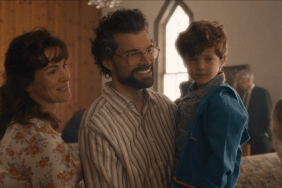
Before receiving Criterion’s new Blu-ray release of Guy Maddin‘s 2007 feature My Winnipeg I hadn’t seen any of Maddin’s films, and about 30 minutes into this one I felt I’d made the right choice. However, as the short, 80-minute, “something like a documentary” played out, I found myself increasingly intrigued. The Lynchian vibe matched with visuals appearing as if it had been made in the mid-’20s, slowly drew me in. I was fascinated by the preposterous (but true) story of Winnipeg’s “If Day“, the idea of a “Ledge Man” television show and then those frozen horse heads… I’ll get to those in just a second.

Described as a “docu-fantasia” by the folks at Criterion, Maddin sets out to tell the story of his hometown of Winnipeg, but in his own unique fashion. Using stories of his childhood to the point he even hires actors (including iconic femme fatale Ann Savage as his mother), he goes so far as to stage scenes from his family’s past. Then there are the stories of Winnipeg, and this blurred, dividing line between truth and fiction. Perhaps my initial inability to find traction within the feature is as a result of this blurred line, not understanding I probably shouldn’t accept everything as reality, though Maddin certainly intends for us to do just that, or, at the very least, a perceived reality.
Maddin’s way of interpreting the city he grew up in speaks to this idea of a filmmaker’s perception of a thing vs. that thing’s reality. It’s a topic that’s found its way into our current cinematic conversation when it comes to Ava DuVernay‘s Selma and DuVernay’s statement against those claiming the film distorts the truth saying, “This is what I see, this is what we see… [a]nd that should be valid. I’m not gonna argue history.”
To this point, included on Criterion’s new Blu-ray release is a nearly hour-long interview between Maddin and frequent collaborator and art critic Robert Enright, discussing the origin of the “documentary” and the stories within. When asked about influences Maddin says he intended for this to be his version of Federico Fellini‘s I Vitelloni before naming such visual and narrative influences as Dziga Vertov‘s Man with a Movie Camera, Walter Ruttmann‘s Berlin, Jean Vigo‘s À Propos de Nice and Oskar Fischinger‘s Walking from Munich to Berlin. Personally I’ve discussed Vigo’s work a couple times in the past and if you click on that link to Fischinger’s Walking from Munich to Berlin you’ll see footage from a film that was made in 1927 and has a look that Maddin has damn near matched with My Winnipeg, and, as it turns out, that’s sort of Maddin’s thing and it really works to his benefit.
Getting to the scene with the frozen horse heads (watch to the right), Enright asks Maddin flat-out about the scene’s veracity and after already admitting he never even answers entirely truthfully during Q&A sessions you immediately realize he’s so well-trained in avoiding the truth he almost can’t help it. He does admit there was a horse stable at Whittier Park that burned down and he does admit to staging the scene as seen in the image at the top of this post, but he never quite directly answers the question as to whether or not horses actually froze to death in the Red River, fleeing the Whittier fire. Even more interesting is a search online for the truth and you can’t find it, but you will find are people that are 100% convinced the above image is real along with several others from the same scene. Again… this idea of perception. The idea of reality vs. a perceived reality can cause for interesting systems of belief.
Maddin’s visual style is also on display in five included short films — Spanky: To the Pier and Back (2008), Sinclair (2010), Only Dream Things (2012), The Hall Runner (2014) and Louis Riel for Dinner (2014) — along with introductions to the first three. To Maddin’s ability to recreate what appears to be vintage footage, my wife stepped in the room as I was watching Only Dream Things and she was like, “What is this… I thought I saw a dead woman.” My reply, “Maybe you did.”
[amz asin=”B00OL0LU2C” size=”small”]In the end, I can’t entirely come to a conclusion on my feelings for this film, but Criterion has put together a wonderful package to help add additional insight into a film and its filmmaker, creating an avenue of understanding. It’s a film where the viewer’s interpretation of the material is imperative and it’s most definitely an art piece, not a movie for general audiences. You have to be willing to explore its inner-workings and motivations and if you’re willing to give yourself over you just might be surprised at how entrenched you become in the snowy, frozen tundra of Maddin’s hometown fantasy.
Also included on this disc are four cine-essays by Maddin from 2014 on various Winnipegiana, a sampling from “My Winnipeg” Live in Toronto, the film’s trailer, a fold out poster featuring art by Marcel Dzama and an essay by critic Wayne Koestenbaum.









